
The purpose of this chapter is to help you choose a suitable diet for balance, harmony, and health in your life, based on Ayurvedic principles. Health-conscious people today are interested in the role good nourishment can play in their healing and in their health. Many have come to realize that proper food and diet can make a vital contribution to good health, while inappropriate eating is often responsible for poor health, lack of vitality, and susceptibility to disease.
The Ayurvedic tradition offers much insight into what food will suit and balance each individual, how to prepare and cook this food properly, how to avoid food combinations that will create toxins in the body, and what eating habits to cultivate—and which to avoid—in order to receive the most nourishment from what you eat. All these topics, except specific guidelines on how to prepare and cook the food, will be discussed in this chapter. (Interested readers may consult Ayurvedic Cooking for Self-Healing by Usha Lad and Dr. Vasant Lad, a complete reference guide to Ayurvedic cooking, including spices and herbs, healing qualities of common foods, menu planning, and dozens of delicious recipes.)
What you eat should be suited to your individual constitution. Ideally, in deciding what to eat, you would know your constitution and understand its relationship to the qualities of various kinds of food, including whether each food would be helpful or aggravating to your unique doshic balance. You would have to take into account the taste of the food (we will discuss that issue later in this chapter), and whether its qualities are heavy or light, oily or dry, liquid or solid. You would also have to know whether the food is cooling or heating (virya), and its postdigestive effect (vipaka).
If you are interested, you can go more deeply into Ayurvedic theory in order to fully comprehend these factors (see the Reading List). Otherwise, the following charts take these factors into consideration in recommending what foods to eat or avoid.
The charts categorize foods according to their suitability for each doshic type. Here are a few points to remember:
• Foods marked “no” tend to aggravate that particular dosha, while foods marked “yes” pacify or balance that dosha. In planning your diet, choose foods that create balance, and avoid those that might provoke your predominant doshas or the dosha that is currently aggravated or increased.
• The recommendations are not meant to be absolute, but are guidelines. If a food is on your “no” list, that means you should avoid it most of the time, and if you eat it, eat a modest amount or do something to modify its effects. Apples, for example, are quite vata-provoking if eaten raw. But if you cook them and eat them warm, with a little ghee and warming spices such as cardamom or cinnamon, they are fine for vata individuals in modest amounts.
• Keep the seasons in mind. Summer, for example, is pitta season, and it is not good—especially for people with a predominantly pitta constitution—to eat too many hot, spicy foods, or pitta dosha will become aggravated. Similarly, during autumn, when the air is dry and cool and more vata is present in the atmosphere, everyone—but especially individuals with a vata constitution—should avoid dry fruit, salads, cold foods, and other vata-provoking items. In winter and early spring, the heavy, cold, moist season of kapha, one should make an extra effort to avoid cold food and drinks, ice cream, cheese, yogurt, melons, and other kaphaincreasing foods.
• For individuals with a dual constitution (two doshas approximately equal), a little extra care is needed, but you can figure it out. For example, a vata-pitta individual needs to avoid vata-increasing foods in the fall and winter (but without increasing pitta too much) and minimize pitta-provoking foods in the summer (but without aggravating vata). Stated in positive terms, favor vata-balancing foods in the fall, pitta-pacifying foods in the summer.
Here are some general dietary guidelines for balancing the doshas:
Vata
Pitta
Kapha
FOOD GUIDELINES FOR THE BASIC CONSTITUTIONAL TYPES
Note: Guidelines provided in this table are general. Specific adjustments for individual requirements may need to be made, e.g., food allergies, strength of agni, season of the year, and degree of dosha predominance or aggravation. *okay in moderation; **okay rarely.


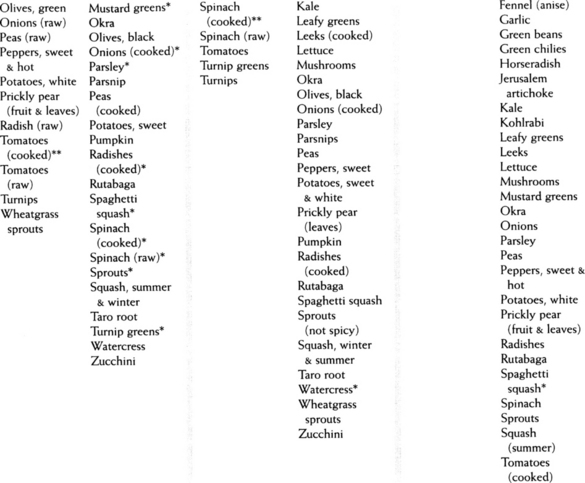

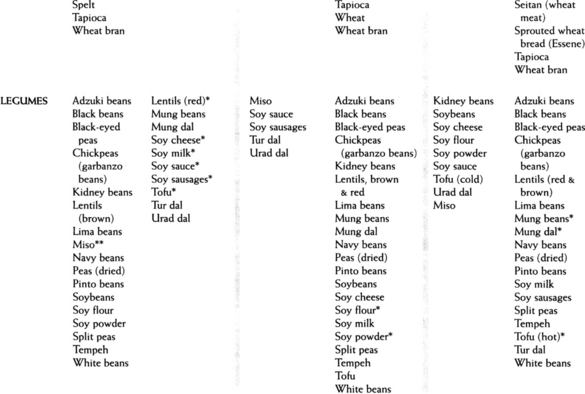

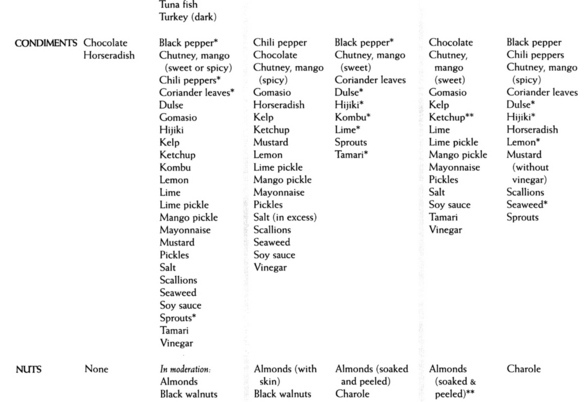
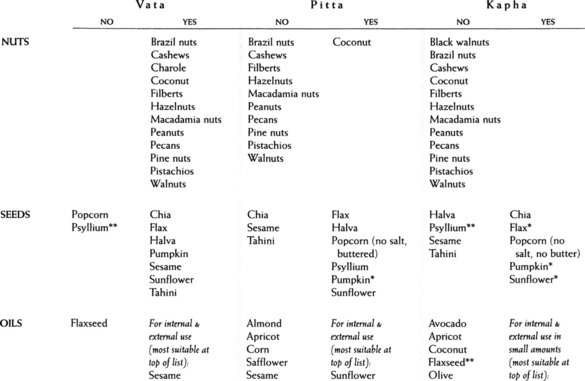
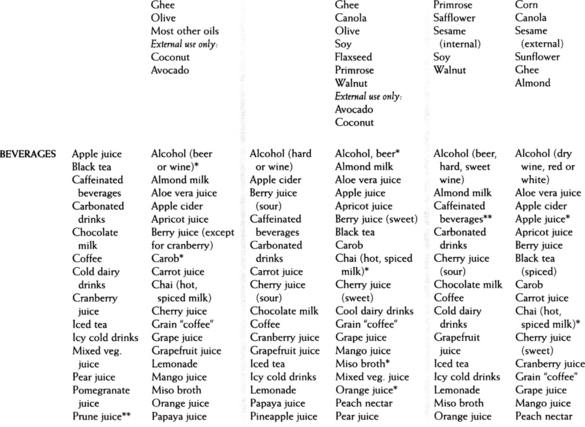
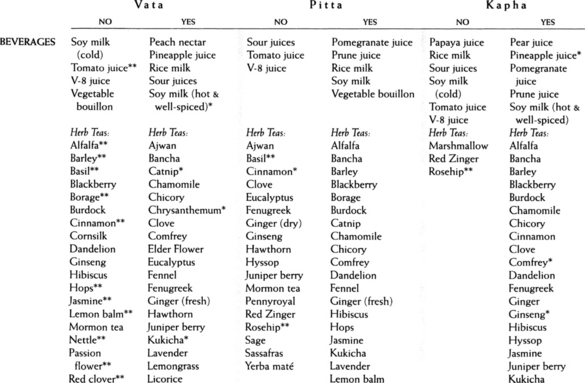
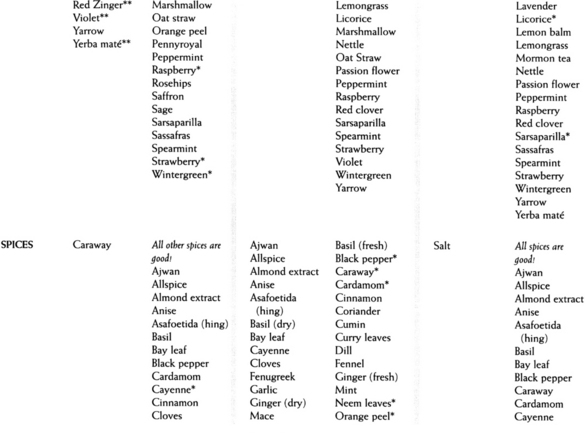
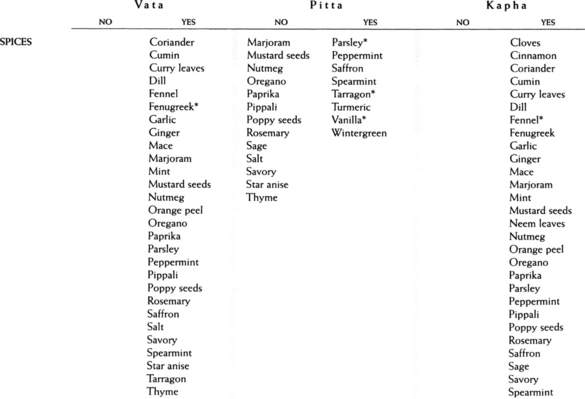
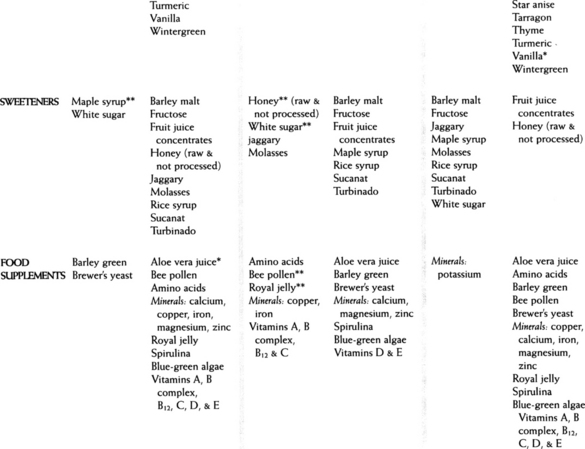
Taste is important and has a direct effect on bodily doshas. According to Ayurveda, each food substance (and also each medicinal herb) has a specific taste. When the tastes are used in the proper amounts, individually and collectively, they bring about balance of our bodily systems.
The taste buds on our tongue are organized in six groups, corresponding to the six tastes recognized by Ayurveda: sweet, sour, salty, bitter, pungent, and astringent. These six basic tastes are derived from the five elements:
Earth + Water = Sweet
Earth + Fire = Sour
Water + Fire = Salty
Fire + Air = Pungent (Spicy)
Air + Space = Bitter
Air + Earth = Astringent
Different groups of taste buds on the tongue perceive taste and send a signal to the brain; from there, messages go out which not only directly influence digestion but also affect the doshas and all the body’s cells, tissues, organs, and systems.
The sweet taste is present in foods such as rice, sugar, milk, wheat, dates, and maple syrup. The qualities of sweet foods are usually oily, cooling, and heavy. The sweet taste increases the vital essence of life. When used moderately, it is wholesome to the body and promotes growth of all seven dhatus (plasma, blood, muscles, fat, bones, marrow and nerve tissue, and reproductive fluids). Proper use gives strength and longevity. It encourages the senses, improves complexion, and promotes healthy skin, hair, and a good voice. Sweet taste can relieve thirst and burning sensations and can be invigorating. It promotes stability.
Despite all these good qualities, excessive use of the sweet taste can produce many disorders. Sweet foods aggravate kapha and cause colds, cough, congestion, heaviness, loss of appetite, laziness, and obesity. They may also provoke lymphatic congestion, tumors, edema, diabetes, and fibrocystic changes in the breast.
The sour taste is found in foods such as citrus fruits, sour cream, yogurt, vinegar, cheese, lemon, green grapes, and fermented food. Sour substances are liquid, light, heating, and oily in nature. When used in moderation, they are refreshing and delicious, stimulate appetite and salivation, improve digestion, energize the body, nourish the heart, and enlighten the mind.
If one uses the sour taste in excess, it can cause excessive thirst, hyperacidity, heartburn, acid indigestion, ulcers, and sensitive teeth. As it has a fermenting action, it may be toxic to the blood and can cause skin conditions such as dermatitis, acne, eczema, boils, and psoriasis. The hot quality may lead to an acid pH in the body and may cause burning in the throat, chest, heart, bladder, and urethra.
Sea salt, rock salt, and kelp are examples of the salty taste. Salt is heating, heavy, and oily. Used moderately, it relieves vata and increases pitta and kapha. Due to its water element, it is laxative, and due to its fire element, it lessens spasm and pain of the colon. In moderation it promotes growth and maintains water electrolyte balance. It stimulates salivation, improves the flavor of food, and aids in digestion, absorption, and the elimination of wastes.
Too much salt in the diet may cause aggravation of pitta and kapha. It makes the blood thick and viscous, causes hypertension, and worsens skin conditions. Feeling hot, fainting, skin wrinkling, and baldness may be due to excessive use of the salty taste. Salt may also induce water retention and edema. Patchy hair loss, ulcers, bleeding disorders, skin eruptions, and hyperacidity may all result from overuse of the salty taste.
The pungent taste is present in various hot peppers (cayenne, chili, black), as well as in onions, radishes, garlic, mustard, and ginger. It is light, drying, and heating in nature. Used in moderation, it improves digestion and absorption and cleans the mouth. It clears the sinuses by stimulating nasal secretions and tearing of the eyes. The pungent taste aids circulation, breaks up clots, helps in the elimination of waste products, and kills germs and parasites. It brings clarity of perception.
On the other hand, overuse of the pungent taste in the daily diet may cause negative reactions. It can kill sperm and ova, causing sexual debility in both sexes. It may induce burning, choking, fainting, and fatigue with feelings of heat and thirst. By aggravating pitta, it can cause diarrhea, heartburn, and nausea. Pungency can also aggravate vata (it is derived from both the fire and air elements), resulting in giddiness, tremors, insomnia, or pain in the leg muscles. Peptic ulcers, asthma, colitis, and skin conditions may result from excessive use.
This taste is found in coffee, bitter melon, aloe vera, rhubarb, and the herbs yellow dock, fenugreek, turmeric root, dandelion root, and sandalwood. Bitter is the taste most lacking in the North American diet. It is cool, light, and dry in nature, increases vata, and decreases pitta and kapha. Though bitter is not delicious in itself, it promotes the flavor of other tastes. It is antitoxic and kills germs. It helps to relieve burning sensations, itching, fainting, and obstinate skin disorders. It reduces fever and stimulates firmness of the skin and muscles. In a small dose it can relieve intestinal gas and works as a digestive tonic. It is drying to the system and causes a reduction in fat, bone marrow, urine, and feces.
Overuse of the bitter taste may deplete plasma, blood, muscles, fat, bone marrow, and semen and may result in sexual debility. Extreme dryness and roughness, emaciation, and weariness may be the result of excessive eating of the bitter taste. It may at times induce dizziness and unconsciousness.
The astringent taste is present in unripe bananas, pomegranates, chickpeas, green beans, yellow split peas, okra, alfalfa sprouts, and the herbs goldenseal, turmeric, lotus seed, arjuna, and alum. It is cooling, drying, and heavy in nature and produces a dry, choking sensation in the throat. Taken in moderation, the astringent taste calms pitta and kapha but excites vata. It helps in the healing of ulcers and stops bleeding by promoting clotting.
Excess use may cause dryness in the mouth, difficulty in speech, and constipation, as well as abdominal distention, heart spasms, and stagnation of circulation. It may affect the sex drive and lead to depletion of sperm. It can give rise to emaciation, convulsions, Bell’s palsy, stroke paralysis, and other neuromuscular vata disorders.
The tastes have the following effects upon the doshas:
VATA. People of vata constitution should avoid bitter, pungent, and astringent substances in excess, because they increase air and have a tendency to cause gas. Foods and herbs containing sweet, sour, and salty tastes are good for individuals of vata constitution.
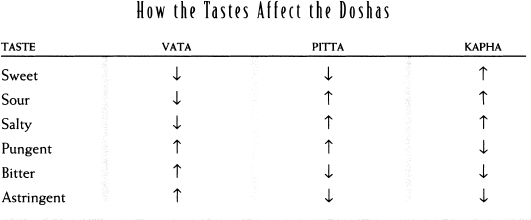
The taste of an herb is not incidental but is directly related—indeed, directly responsible—for much of its therapeutic value. That is why Ayurvedic herbs are generally taken in a form that requires tasting them, rather than concealing the taste in a capsule.
There is no problem in taking an herb that has a sweet, pungent, or otherwise tempting taste. But most people, particularly in Western culture, don’t like the bitter or astringent tastes, and if they have to take an herb with either of these tastes, they want to put the herb into a capsule and swallow it without tasting it. Since the stomach has no taste buds, when the herb is taken this way, the effects and benefits derived from the taste are lessened, because they are not perceived. When we eat food, we don’t lose the effect of the tastes because we have to chew; when we use capsules, we miss the taste of the herb.
One of the reasons the Ayurvedic physician prescribes an herb is to balance whatever taste is lacking in the body. The herb transmits that taste and its effects into rasa dhatu (plasma). Triphala, for example, provides all the tastes except salty, but it tends to yield the predominant taste that is lacking in the body, which for most Westerners is the bitter taste. That’s why for many people triphala tastes bitter for some time. Later, after regular use, the bitter taste will have been received into the rasa dhatu, and triphala may taste sour or sweet.
In Ayurvedic medicine, most herbs are classified according to their predominant taste, secondary aftertaste, and “potential” taste. The main taste acts on rasa dhatu, the aftertaste acts on the nervous system, and the third taste has either a heating or a cooling effect.
This explains why it is important to have the effect of taste on the tongue when taking Ayurvedic medications.
PITTA. Pitta individuals should avoid sour, salty, and pungent substances, which aggravate bodily fire. However, sweet, bitter, and astringent tastes are beneficial for pittas.
KAPHA. Kapha individuals should avoid foods containing the sweet, sour, and salty tastes, for they increase bodily water. Better for them are foods with pungent, bitter, and astringent tastes.
How you eat is as important as what you eat. Here are some suggestions for healthy eating, followed by a list of habits to avoid.
The shelves of pharmacies and health food stores these days are lined with digestive aids and pills for indigestion and gas. It is likely that most of these gastrointestinal problems begin with poor food combining.
According to Ayurveda, certain food combinations disturb the normal functioning of the gastric fire and upset the balance of the doshas. Combining foods improperly can produce indigestion, fermentation, putrefaction, and gas formation. If such a situation in your stomach and intestines is frequent or prolonged, it can lead to disease. As just one example, eating bananas with milk can diminish agni (gastric fire) and change the intestinal flora, resulting in toxins and causing sinus congestion, cold, cough, allergies, hives, and rash. Such disturbances generate ama, the toxic substance that is the root cause of most ailments.
The following table lists some (but far from all) of the incompatible food combinations worth avoiding. You can alleviate some of the ill effects of these combinations by using spices and herbs in your cooking. A strong digestive fire can be the most powerful means of dealing with these combinations. Chew a bit of fresh ginger (sprinkled with salt and lime juice if you like) before meals to stimulate digestion.
| NAME OF FOOD | INCOMPATIBLE WITH |
| MILK | BANANAS |
| Fish, Melons, Yogurt, Sour Fruits, Kitchari (mung dal and basmati rice), Bread made with yeast | |
| YOGURT | MILK |
| Sour fruits, Melons, Hot drinks—including coffee and tea—Fish, Mango (thus mango lassi is not a good idea), Starches, Cheese, Banana | |
| MELONS | EVERYTHING, especially: |
| “Eat them alone or leave them alone” | Grains, Starches, Fried foods, Cheese |
| EGGS | MILK |
| Yogurt, Melons, Cheese, Fruits, Potatoes | |
| STARCHES | BANANAS |
| Eggs, Milk, Dates | |
| HONEY | GHEE in equal proportions (by weight) |
| (never cook honey) | Grains |
| CORN | Dates, Raisins, Bananas |
| LEMONS | Yogurt, Milk, Cucumber, Tomato |
| NIGHTSHADES (Potato, tomato, eggplant) | Yogurt, Milk, Melon, Cucumber |
Particularly to be avoided are such concoctions as banana milkshakes and “fruit smoothies” made with milk. Mixed fruit salads are also incompatible. Some blended fruit drinks made with all fruit may be all right, but check this chart first.
Recommendations Regarding Milk and Milk Products
In Ayurveda, milk and dairy products such as ghee and freshly made yogurt are considered highly important to the diet. However, the process of pasteurization, which kills bacteria and other potentially harmful microorganisms, may also destroy the enzymes necessary for proper digestion. If the milk is heated for a fairly long period of time, such as fifteen or twenty minutes, the enzymes will definitely be destroyed, and calcium and other nutrients may not be absorbed.
When milk is heated just until it reaches the boiling point, its enzymes are not destroyed, and it becomes less kaphagenic. So if you can obtain organic, unpasteurized milk from certified dairies and heat it just to the boiling point, that would be best.
Nevertheless, pasteurized milk from the supermarket, and dairy products made from that milk, are still better than no dairy products at all.
Note that for each food in capital letters on the left, the food in capitals on the right is the most incompatible; foods in small letters are less incompatible.
The Ayurvedic tradition teaches that food is not only for nutrition, to nourish the body, but also affects the mind and consciousness. As we have a physical constitution (vata–pitta–kapha), we also have a mental constitution characterized by the three gunas: sattva, rajas, and tamas.
According to the Sankhya philosophy of creation, sattva, rajas, and tamas are universal qualities necessary for the creation of the universe (see this page). They are equally necessary for maintaining our psychobiological functions.
Because of sattva, we remain conscious and reawaken every morning. Because of rajas, our thoughts, feelings, and emotions move in a creative way. Because of tamas, we become tired, exhausted, and heavy; without tamas there is no sleep. Another way to look at it is that sattva brings clarity, rajas brings perception, and tamas gives solid, concrete experience.
These three qualities are also necessary for the functioning of every cell. Satva is potential energy, rajas is kinetic energy, and tamas is inertia. The potential energy in the cell is awareness; it becomes active due to the kinetic energy of rajas; then the cell becomes inert because of the tamasic quality. Thus these three qualities are absolutely necessary for the psychobiological activities of the human body.
Psychological Constitutions
Indian philosophy classifies human temperaments into three basic types: sattvic, rajasic, and tamasic. These types all differ in psychological and moral disposition, as well as in their reactions to social, cultural, and physical conditions, as is described in the classical texts of Ayurveda.
Sattvic qualities imply essence, reality, consciousness, purity, and clarity of perception. People in whom sattvic qualities predominate are loving, compassionate, religious, and pure-minded, following truth and righteousness. They tend to have good manners and positive behavior, and they do not easily become upset or angry. Although they work hard mentally, they do not get mental fatigue, so they need only four to five hours of sleep at night. They look fresh, alert, aware, and full of luster and are recognized for their wisdom, happiness, and joy. They are creative, humble, and respectful of their teachers. Worshiping God and humanity, they love all. They care for people, birds, animals, and trees and are respectful of every life and existence.
Rajasic individuals are loving, calm, and patient—so long as their own interests are served! All their activities are self-centered and egotistical. They are kind, friendly, and faithful only to those who are helpful to them.
All movement and activity is due to rajas, which leads to the life of sensual enjoyment, pleasure and pain, effort and restlessness. People in whom rajasic qualities predominate tend to be egoistic, ambitious, aggressive, proud, and competitive and have a tendency to control others. They like power, prestige, and position and are perfectionists. They are hard-working people but may be lacking in proper planning and direction. Emotionally they tend to be angry, jealous, and ambitious and to have few moments of joy. They suffer from a fear of failure, are subject to stress, and are quickly drained of mental energy. They require eight hours of sleep.
Tamas is darkness, inertia, heaviness, and a tendency toward materialism. Individuals dominated by tamas are often less intelligent. They tend toward depression, laziness, and excess sleep, even during the day. A little mental work tires them easily. They like jobs with less responsibility, and they love to eat, drink, sleep, and have sex. They tend to be greedy, possessive, attached, irritable, and uncaring toward others. They are willing to harm others for their own self-interest.
There is a constant interplay of these three gunas in everyone’s consciousness, but the relative predominance of either sattva, rajas, or tamas is responsible for an individual’s psychological constitution.
In the Ayurvedic literature, food is classified as sattvic, rajasic, or tamasic according to the mental qualities it promotes. In brief, sattvic food is light, healthy food that increases clarity of mind, rajasic food is tempting food that increases activity and agitation, and tamasic food is heavy, dulling food that creates depression and heaviness and leads to many disorders.
Sattvic food is light and easy to digest. It brings clarity of perception, unfolds love and compassion, and promotes the qualities of forgiveness and austerity. Sattvic foods include fruit, steamed vegetables, and fresh vegetable juice. Milk and ghee are sattvic foods that build up ojas and give vitality to prana.
Rajasic foods are hot, spicy, and salty. They are irritants and stimulants, and they are tempting foods (once your hand goes into the bag, you cannot stop eating them), such as salty crackers and potato chips. Rajasic foods also include certain heavily spiced foods, such as hot pickles and chutneys, which stimulate the senses. These foods make the mind more agitated and susceptible to temptation. Gradually, from eating these foods, the mind becomes more rajasic, which means it tends toward anger, hate, and manipulation.
Tamasic food is heavy, dull, and depressing and induces deep sleep. Under that category comes any dark meat, lamb, pork, and beef, as well as thick cheese. Old and stale food is also tamasic.
However, the heavy, dulling effect of tamasic food occurs only when it is eaten in excess. In moderation, tamasic food is grounding and promotes stability. If, for example, an individual has an excess of the rajasic quality—the mind is hyper and ungrounded and there is insomnia—some tamasic food eaten in moderation will help the person become more grounded and get some sleep.
We can classify food into categories of sattvic, rajasic, or tamasic according to the table on the facing page.
Students of Ayurveda frequently ask whether there is a relationship between the three gunas and the three doshas. There is not a direct correspondence, but there is a relationship.
Sattva is present in the doshas in this order:
Tamas is present in the doshas in this order:
Rajas, active and hyper, is present in vata and in pitta but is virtually absent from kapha.
Vata is approximately 75 percent rajas, 20 percent sattva, and 5 percent tamas. Pitta is 50 percent or more sattva, 45 percent rajas, and up to 5 percent tamas. Kapha is maybe 75 percent tamas and 15 to 20 percent sattva, with very little rajas. Here is another way we can see these relationships:
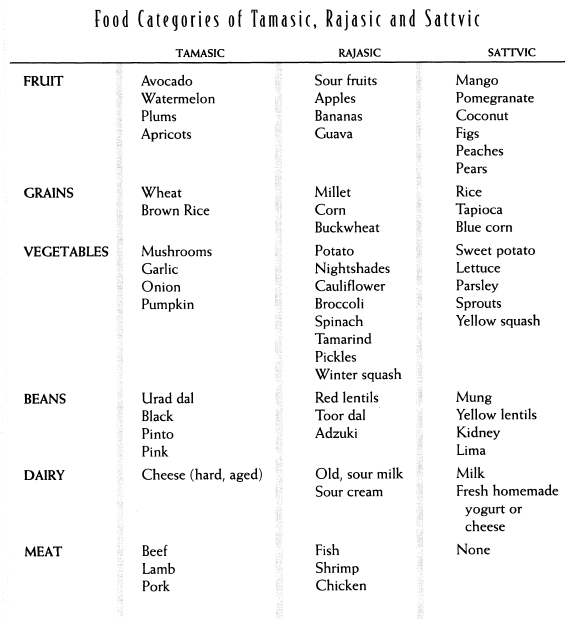
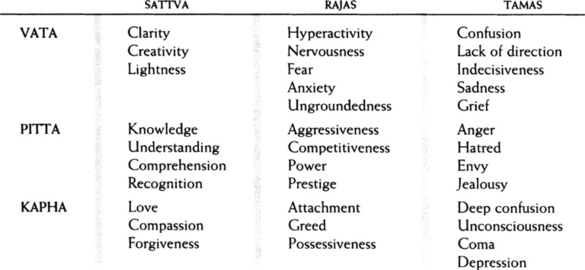
Now you have more than enough background information to benefit from the remedies and recommendations made in Part III. I hope you have enjoyed this introduction to Ayurveda and that you will incorporate its principles and practices into your life. If you do, I know your health will improve and your life will blossom physically, mentally, emotionally, and spiritually.